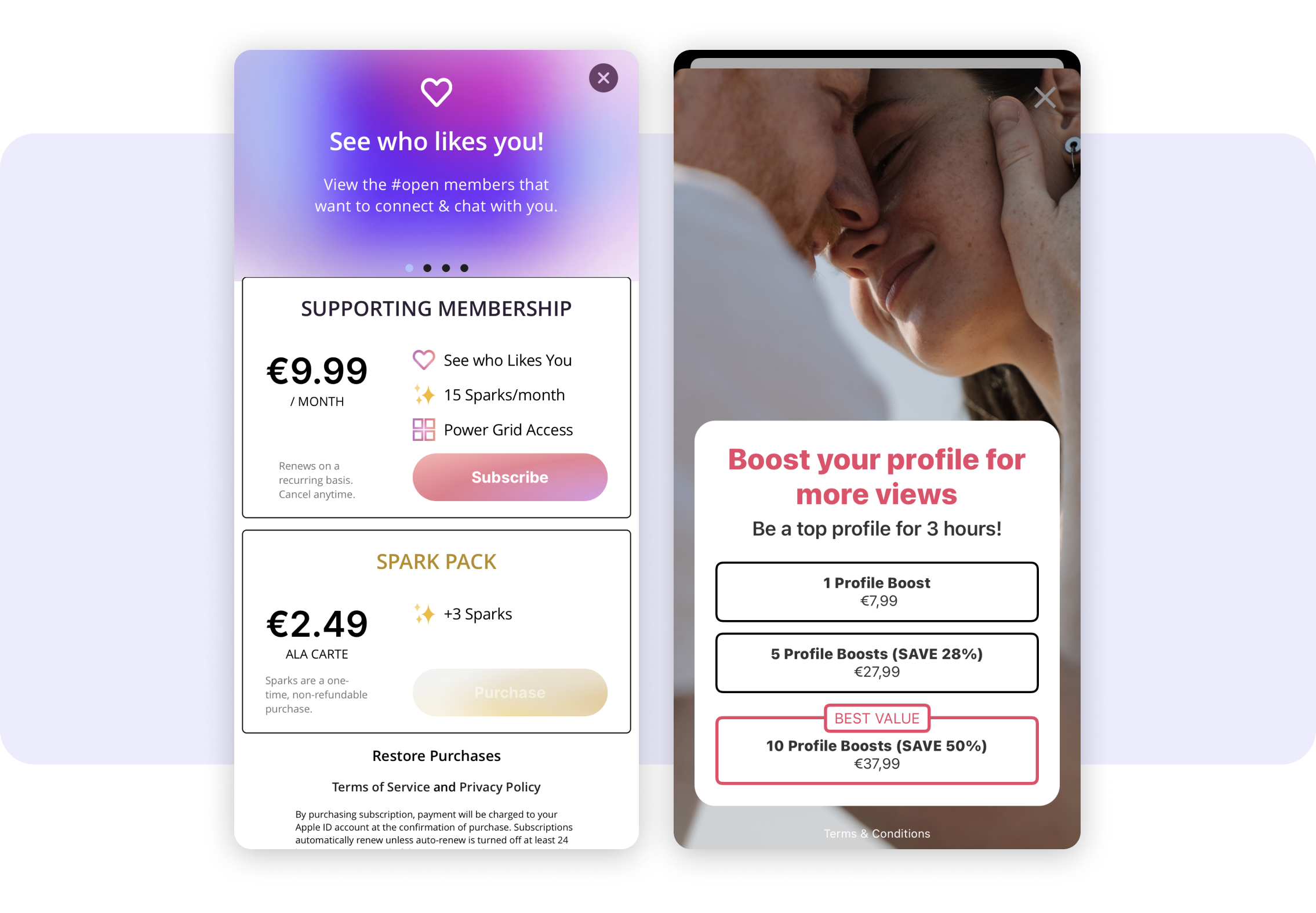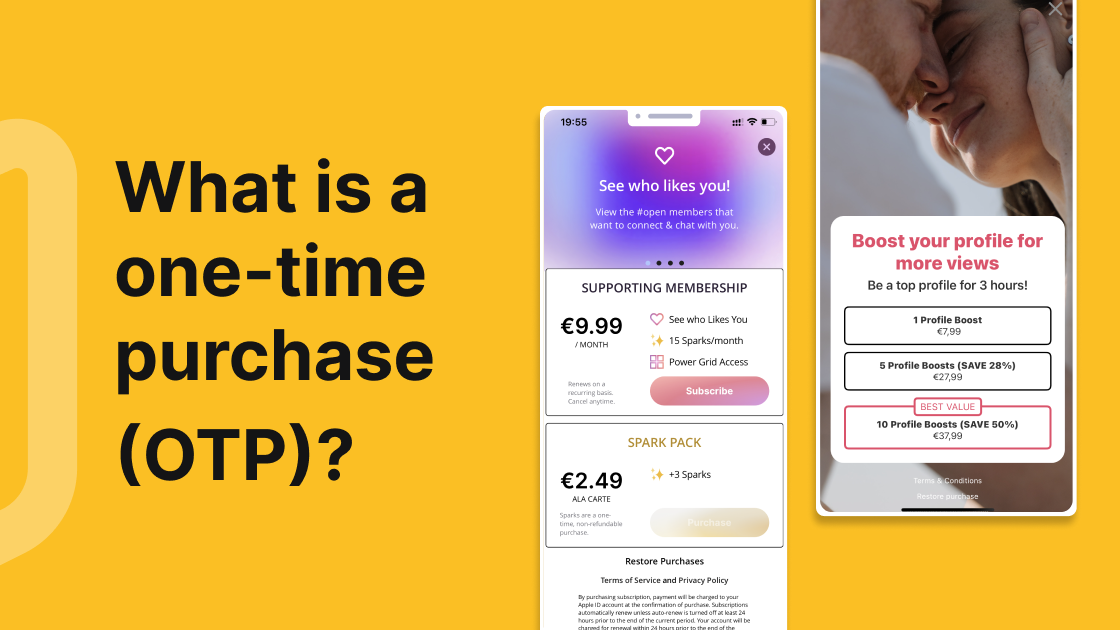The subscription model has revolutionized the way businesses monetize their products and services. More and more companies are turning to recurring payments from streaming services to mobile game apps o build up recurring revenue streams and increase customer lifetime value. But what if one-time purchases (OTP) are still the way to go?
This article is the first part of our series about one-time purchases.
In this article, we’ll explore:
- What is a one-time purchase?
-
The advantages and disadvantages of one-time purchases (OTP)
-
One-time purchases OTP examples
-
Differences between the one-time purchase and the subscription model
-
How they can be successfully combined to create a hybrid monetization strategy
The second article of this 2-part series is "why some one-time purchases work" and details why one-time purchases are still a viable pricing strategy to consider for certain industries and products.
What is a one-time purchase?
A one-time payment is a billing option where users make a one-off payment for a product or service without additional or ongoing charges. It’s what you might call the traditional payment model, either on a mobile device, a mobile or desktop app, or a website. For example, buying the latest iPhone via a one-time fee falls under the one-time purchase category, whereas paying for a monthly gym membership or falls under the subscription category.
That’s the standard definition anyway. At Purchasely, we believe it’s more than just a transaction. It’s an opportunity to deliver an exceptional user experience that will demonstrate your product’s value, build trust and loyalty with users, and keep users coming back, whether buying items at an e-commerce store or buying add-ons and bonuses while playing mobile games.
Pros and cons of one-time payments
Like any payment method, there are pros and cons. While subscription plans are becoming more common, there are still many benefits of offering one-time payments.
Some of the pros include:
Simplicity - One-time payments keep things simple for users. No additional payments, no need to subscribe, and set a reminder to cancel later. It allows customers to pay for what they need and move on.
Instant revenue - This is one of the biggest advantages. With payments being made in full and upfront, it means you have capital immediately to reinvest in other areas of the business.
Low commitment - For users who don’t want to commit to ongoing payments or don’t have ongoing services, a one-time purchase option is always good to have.
However, some of the cons of a one-time payment model include:
Higher upfront costs - One-time payments require higher price points. This can make it more difficult to convert prospects and shoppers into customers. Total revenue may also be lower due to lower conversion rates.
Less predictable revenue - The biggest advantage of the subscription model is the biggest problem for one-time payments. Without having built-in recurring payments, it’s difficult to predict when users will come back to buy again. It may also mean you have to spend more time - and money - on acquisition instead of retention.
Limited upsell opportunities - Subscription app users are typically more actively engaged to ensure they get the most out of their ongoing investment. It means these apps have more opportunities to drive further In-App Purchases, compared to one-time payment apps where there is no guarantee they’ll return.
Examples of one-time purchases
Let’s take a quick look at some examples of what one-time purchases look like when it comes to mobile apps.
Consumable purchases

Consumable OTP paywall examples of #open(left) and Socynd(right).
These are In-App Purchases (IAP) that expire once used up and can be bought again. Examples include currency in free-to-play games, extra lives, health points, etc.
Consumables are popular mobile games. For some games, they’ve even been embedded into the game’s structure to give players an advantage over others. For example, in Clash of Clans, players can buy gems to build villages and compete in clan wars - actions that enable the player to progress in the game.
Non-consumable purchases
.png?width=736&height=510&name=non-consumable%20OTP%20(1).png)
Non-consumable OTP(lifetime subscription) paywall examples of stats.fm (left) and Earthsnap (right).
Non-consumables are the opposite. Users buy once and then have access to the item forever. Examples include:
- Extra levels or upgrade options in a mobile game app
- A report for a SaaS product
- A course in an ed-tech app
- Lifetime subscription (we will detail this later in the article)
We’ve written an article about the 50 most successful examples of apps with In-App purchases for those who want to read more on this topic.
One-time purchase vs. the subscription model
We can’t talk about one-time payments without touching on subscriptions.
Over the last decade or so, subscriptions have become the dominant monetization model for companies across all industries, particularly for cloud services. For example, before you could go and buy a Microsoft 365 package outright, but that’s not the case anymore. Microsoft and other big software players all charge recurring monthly subscription fees for their products these days instead.
And it’s not just software where this shift to subscriptions is happening. Streaming services like Netflix, DTC retail brands, gaming apps, dating apps, and even delivery apps all use subscriptions to build recurring revenue streams that help them better predict future revenue, increase customer lifetime value and deliver better products.
What are the benefits of subscription apps?
There are lots of subscription benefits. For consumers, they’re convenient, are less prohibitive because they allow users to spread costs, and generally offer users a better user experience because app developers need to provide regular updates, automatic upgrades and new content to keep users happy, engaged, and feel like they’re getting value for money.
But it’s not just consumers who benefit from subscriptions. App companies tend to see higher revenue per user, higher engagement rates, better LTV, which can have a positive impact on rankings in the app stores. Subscription models also provide a getaway for your app to promote content, consumables and other In-App Purchases to drive further user monetization.
For the definitive guide to subscription business models, check out this article written by our co-founder and CEO, Nicolas Tissier.
Combining the one-time payment and subscription model
Which is the best payment method to use for your subscription app? The answer is going to be different for everyone, of course. But you could consider combining the two payment methods and creating a hybrid monetization strategy to increase revenue.
One of the best-known examples of this is Peloton, the exercise bike which comes with live and on-demand virtual classes. Shoppers pay an upfront cost of $1,445 for the bike itself, and then an ongoing subscription of $44/mo for alan l-access membership to classes.
Another example is Jodel a social media platform that serves as an uncomplicated and easy-to-use bulletin board for local communities. You may listen our podcast Shifting from ads to In-App Subscription-led revenue generation with Tim Schmitz (Jodel) to learn how Jodel combines an advertising product available via one-time purchase and a subscription plan with no ads.
Other well-known examples are lifetime memberships which are one-time payments. The beauty of this lifetime subscription is that apps have to focus only on conversion and may save any resources required for retention (as lifetime memberships mean no retention).
Babbel, one of the leading language-learning apps in the world, provides such a lifetime subscription for 3-digit pricing. Any lifetime subscriber gets unlimited access to all 14 languages and can refresh his skills or learn another language whenever he wants, forever.
The pricing definition of such lifetime membership could be tricky:
- If the price is too low, the generated revenue may be below the addressable market,
- If the price is too high, the offer will attract a microniche segment.
A good rule of thumb is to price it around 2-4 years of the monthly rate. So, if the monthly subscription price is $10, the lifetime price should be in the range of $50-$500.
For mobile games, the traditional methods of monetization have been In-App Purchases and in-app ads. But more developers have been experimenting with subscriptions in the last few years as a way to offer users a premium subscription.
XFLAG, an Android game developer, reports that subscribed users of their game, Monster Strike, play more on a daily basis compared to users who aren’t subscribed. Scopely, another Android developer, says that subscribed players have higher Average Revenue Per User (ARPU) compared to non-subscribers, which leads to a higher LTV.
Even if you don’t believe your product or service is suited to a subscription model, it’s worth challenging that assumption. By combining the many benefits of subscriptions with In-App Purchases or in-app advertising, you should be able to find the right balance of monetization tactics for your business.
Key takeaways
• One-time purchases are a great option for monetizing mobile apps but can be unpredictable in terms of user engagement and revenue.
• Subscriptions are an increasingly popular monetization option and offer lots of advantages, including predictability, engagement, and customer retention.
• Combining one-time purchases and subscriptions can open up a range of options for businesses to boost their revenue and user engagement. Lifetime membership is a pricing strategy to be tested.
• Businesses should regularly review their monetization strategies to ensure they’re getting the most out of their investments.
Increase In-App purchases with Purchasely
Purchasely is the monetization platform for apps that provide one-time purchases and In-App Subscriptions.
Purchasely will help you increase one-time buyers and subscribers and build a sustainable, predictable revenue model with smarter purchase screens and paywalls, no-code campaigns, real-time analytics, and a whole bunch more.
Want a product walkthrough? Book a Purchasely demo and see how you can grow revenue by increasing your In-App purchases today.
We also have lots of resources to help you such
all packed with tactics to help you increase subscription adoption rate or in-app purchases, convert more users, improve retention rate, and avoid churn.
.png)
.png)


.png?width=736&height=510&name=non-consumable%20OTP%20(1).png)


